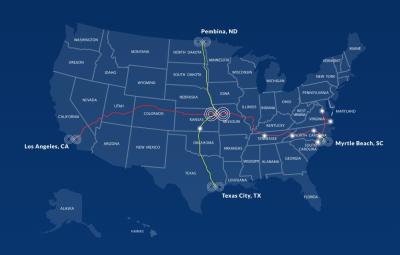Infrastructure company 3Red8 has a plan to build a new open access dark fiber network by 2027 that, like the interstate highway system, will crisscross the U.S. and allow a free flow of traffic from coast to coast and border to border. While 3Red8 itself plans to operate using a wholesale business model, company executives told Fierce they’re hoping to partner with internet service providers (ISPs), co-operatives and municipalities to use their fiber backbone to help close the digital divide.
3Red8’s network plan is an ambitious one. The company is currently planning to run fiber all the way from Los Angeles, California in the west to Myrtle Beach, South Carolina in the east, with a north-south route from Pembina, North Dakota to Texas City, Texas pretty much evenly bisecting the country. All told, it’s looking to deploy more than 70,000 route miles of fiber across 18 states, with edge data centers stationed about every 50 miles along the way. Partners on the project include Quanta Telecom, Schneider Electric, Dentons, EDJX and Deloitte.

Initial work will focus on a smaller north-south route that will run from the data center hub of Ashburn, Virginia to Myrtle Beach, which is expected to become a key subsea cable landing station. The route will also include a branch off to the west to hit Ashville, North Carolina along the way. This path is expected to be completed by the end of 2023.
Mark Adams, 3Red8’s cofounder and chief development officer, said the company will function as a traditional wholesale operator, selling dark fiber to hyperscalers and other large entities which want to buy in large quantities. That’s in part why it’s starting with the Ashburn to Myrtle Beach route. It will also be offering point-to-point wavelength services and other products as well. Looking ahead, expansions toward its nationwide goal will be focused opportunistically on regions with data center clusters and other areas that present near term commercial opportunities, he said.
But the company also recognizes that its infrastructure will present a unique opportunity to help close the digital divide. 3Red8’s Head of Strategy and Impact Tamara Rajaram said in nearly every state it plans to traverse, “just about 25 to 30 percent of the population touches our route.” Many of the areas along the way are rural and underserved communities, she added. While the company has no plans to offer last mile connectivity itself, it is pushing hard to partner with other entities like ISPs, utilities, cooperatives and even municipalities themselves to close that gap.
“What we do hope is that every community will be able to plug in to this new latest and greatest transport or backhaul,” she said. “That truly allows this, in terms of capacity and connectivity, to waterfall the last mile to the end user. And that’s our vision and what we spend a lot of time trying to work out.”
Adams concluded: “The reason why these communities don’t have good connectivity today is there’s been market failure. It hasn’t been economic for legacy providers to put in decent broadband connections to these communities. That’s fundamentally what the problem is. We are here in a spirit of partnership to help them solve that.”